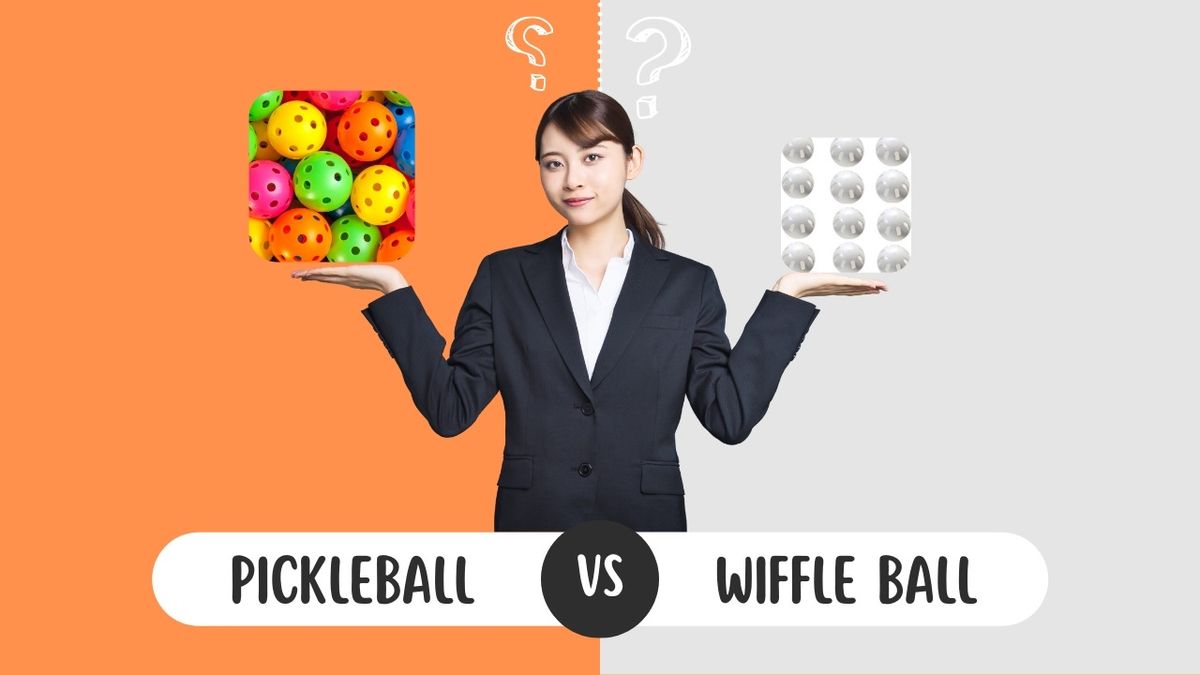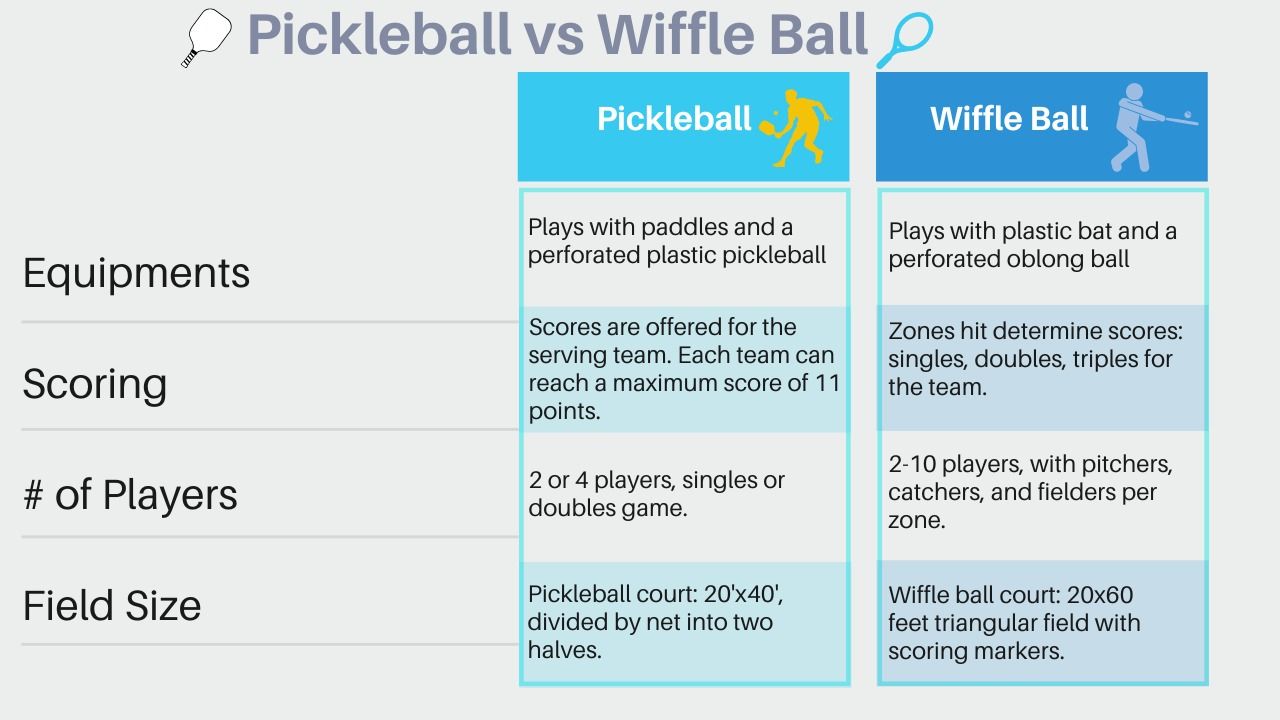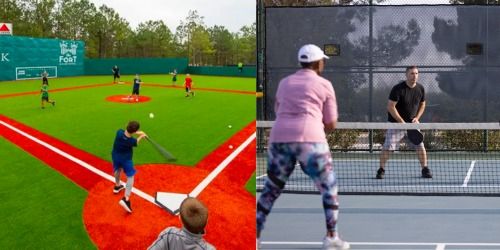Pickleball vs Wiffle Ball - Unveiling the Ultimate Game!
Discover the ultimate face-off between two classic summer games - Pickleball and Wiffle Ball. Unravel the differences and similarities.

Are you ready for a showdown of epic proportions?
In one corner, we have the fast-paced, adrenaline-pumping sport of pickleball, and in the other corner, the classic, backyard favorite, wiffleball!
Both games are known for their fun and friendly competition, but which one reigns supreme?
Today, we'll delve into the world of pickleball vs wiffle ball, exploring their origins, gameplay, and unique charms.
So, grab your paddles and balls, and let's dive into this exciting match-up to determine which game will be crowned the champion of summer fun!
How Does A Pickleball Ball And A Wiffle Ball Differ?
Pickleball balls and Wiffle balls may look similar at first glance, but they have significant differences that affect gameplay. The most noticeable difference lies in their construction. Pickleball balls are made of durable, hard plastic with precisely placed holes, which contributes to their unique flight characteristics and consistent bounce on the court.
On the other hand, Wiffle balls are constructed from lightweight, hollow plastic with a pattern of oblong slots. This design gives Wiffle balls a slower and more unpredictable flight path, perfect for casual backyard play. Additionally, the size and weight of the balls vary, with Pickleball balls being slightly smaller and heavier than Wiffle balls. These distinctions result in distinct playing experiences, making each game a world of its own.

Field
Wiffle ball, a baseball derivative, is often played in backyards and streets using a plastic bat to toss the resilient plastic ball.

Pickleball is a doubles sport played on a 20x44 feet court, divided with a low net, featuring a no-volley zone in the center for serving restrictions.
Balls
Pickleball balls and Wiffle balls differ in their design and construction, leading to unique characteristics that impact gameplay. Pickleball balls are made of hard, durable plastic with precisely placed holes, allowing for a consistent bounce and flight pattern on the court.
The holes in a Pickleball ball are smaller and more uniform, contributing to a controlled trajectory during rallies. In contrast, Wiffle balls are made of lightweight, hollow plastic with larger oblong slots. This design creates a slower and more unpredictable flight path, making Wiffle ball games entertaining for backyard fun.
Wiffle Ball Varieties
Some of the common Wiffle ball varieties include:
- Traditional Wiffle Ball: This is the classic, standard Wiffle ball, made of lightweight, hollow plastic with oblong slots. It provides a slower and more unpredictable flight path, making it ideal for casual backyard play.
- Wiffle Ball Pro: The Pro version is designed for more serious players and competitive games. It features a slightly heavier weight and smaller slots, offering improved control and accuracy during play.
- Wiffle Ball Fastpitch: This variety is designed for fastpitch softball-style play. It has larger holes and a faster flight path, making it suitable for players looking for a more challenging and dynamic game.
- Wiffle Ball Baseball: This version is shaped more like a baseball and is used for Wiffle ball games with baseball rules. It provides a unique blend of baseball and Wiffle ball gameplay.
- Wiffle Ball Golf Ball: This is a small-sized Wiffle ball designed for playing Wiffle ball golf, a fun variation of the game where players hit the ball into designated targets around a course.
Each variety of Wiffle Balls offers a different experience and caters to the diverse interests of players, making Wiffle Ball a versatile and enjoyable game for all ages.
Why Do Pickleball Balls And Wiffle Balls Have Different Holes?
Pickleball Balls
Pickleball balls have smaller, evenly spaced holes on their surface, usually around 26-40 holes. The holes in pickleball balls are strategically designed to reduce wind resistance, minimize flight deviations, and provide a more controlled flight path. The smaller holes also make pickleball balls more durable, allowing them to withstand the rigors of the fast-paced game.
Wiffle Balls
Wiffle balls have larger, oblong slots or holes on their surface. The unique hole design of Wiffle balls contributes to their slower and more erratic flight path, providing a fun and unpredictable element to the game. The larger holes also give the ball a softer feel, making it safer for casual play in backyards or confined areas.
Pickleball Balls
Pickleball is made to have the right balance of bounce, weight, and durability to enhance gameplay. The materials used in making pickleball balls include:
- Plastic: Pickleball balls are a type of durable plastic, often referred to as "polymer" or "high-impact plastic." This plastic is chosen for its ability to withstand repeated impacts without cracking or breaking.
- Perforations: Pickleball balls have evenly spaced holes or perforations on the surface. These perforations reduce air resistance and help maintain the ball's flight stability, ensuring it doesn't travel too fast or unpredictably.
Wiffle Ball
The materials used in making a wiffle ball include:
- Plastic: The type of plastic used is generally polyethylene, which is known for its flexibility and durability.
- Perforations: Similar to pickleball balls, wiffle balls also feature perforations. These perforations come in various patterns and sizes, affecting the ball's flight and its tendency to curve or "break" during pitching.
- Design: Wiffle balls have a unique design with oblong and symmetrical cut-outs around the ball's surface. These cut-outs help create air turbulence when the ball is thrown, causing it to move unpredictably and making it more challenging to hit.
Both pickleball balls and wiffle balls are designed to be safe for players while maintaining the right balance of bounce and movement for an enjoyable playing experience.
How Durable Are Pickleball Balls And Wiffle Balls?
The durability of pickleball balls and wiffle balls can vary based on the specific materials used by different manufacturers. Let's take a closer look at each:
Pickleball Balls: Pickleball balls are generally designed to be quite durable, as they need to withstand the impact of the paddle and the court surface during gameplay.
Wiffle Balls: Wiffle balls are typically made from lightweight, hollow plastic, which makes them less durable compared to pickleball balls. The plastic used is often thinner than that of pickleball balls, making wiffle balls more prone to damage from high-impact hits or being stepped on.
Bounce Attributes For Pickleball Balls And Wiffle Balls
The bounce attributes of pickleball balls and wiffle balls are essential factors that significantly impact gameplay in their respective sports.
Pickleball Balls: Pickleball balls are designed to have a controlled and predictable bounce, making them suitable for the fast-paced nature of pickleball. The primary attributes of the bounce are as follows:
- Low to Medium Bounce: Pickleball balls have a relatively low to medium bounce compared to traditional tennis balls. This characteristic allows players to maintain better control over the ball during rallies and promotes the strategic use of angles and shots.
- Consistent Bounce: A good-quality pickleball ball will provide a consistent bounce on various surfaces, ensuring fair gameplay and a level playing field for all players.
- Impact-Responsive Bounce: The bounce of a pickleball is directly influenced by the force of the impact. Harder shots result in a slightly higher bounce, while softer shots produce a lower bounce.
- Durability and Bounce Retention: The durability of the ball also affects its bounce attributes over time. A new ball will have a livelier bounce compared to a ball that has been in use for an extended period.
Wiffle Balls: Wiffle balls have unique bounce attributes due to their hollow plastic construction and perforations. These characteristics make them ideal for the fun and casual gameplay of wiffle ball:
- Low Bounce: Wiffle balls have a very low bounce, which is intentional to add an element of challenge to hitting and catching the ball during wiffle ball games.
- Inconsistent Bounce: The air turbulence caused by the perforations and cut-outs on the surface of wiffle balls results in an unpredictable bounce. This unpredictability adds an entertaining and challenging aspect to the game.
- Air Ball Characteristics: Wiffle balls are often used in backyard games where players use different types of pitches, including "curveballs" and "sliders." These pitches exploit the airflow around the ball to create movement, making them fun to throw and challenging to hit.
- Safety Considerations: The low bounce and lightweight nature of wiffle balls make them safer for backyard play, as they are less likely to cause injury compared to harder balls used in other sports.
Pickleball VS Wiffle Ball
FAQs
Q: What's the difference between a pickleball and a wiffle ball?
Answer:
1. Purpose:
- Pickleball Ball: The pickleball ball is a specialized ball designed specifically for the sport of pickleball. It is used in organized pickleball matches and tournaments.
- Wiffle Ball: The wiffle ball is a recreational ball primarily used for casual backyard games and informal play, especially in a simplified version of baseball called "wiffle ball."
2. Sport:
- Pickleball Ball: The pickleball ball is used in the sport of pickleball, which is a paddle sport that combines elements of tennis, badminton, and table tennis. The game is played on a rectangular court with a net in the middle.
- Wiffle Ball: The wiffle ball is not associated with a specific sport, but it is commonly used for informal and friendly games of wiffle ball in backyards, parks, and other open spaces.
3. Construction:
- Pickleball Ball: The pickleball ball is a solid, perforated plastic ball with a smooth surface. It is made of a durable plastic material and has evenly spaced holes for reduced air resistance and stable flight.
- Wiffle Ball: The wiffle ball is a hollow, lightweight plastic ball with oblong and symmetrical cut-outs on its surface. These cut-outs create air turbulence, resulting in unpredictable flight patterns when thrown.
4. Bounce Attributes:
- Pickleball Ball: The pickleball ball has a controlled and consistent bounce, with a low to medium bounce height, suitable for the strategic and fast-paced nature of pickleball.
- Wiffle Ball: The wiffle ball has a very low bounce due to its hollow construction. Additionally, the air turbulence caused by the cut-outs on the surface creates an unpredictable bounce, making it challenging and fun to hit.
5. Gameplay:
- Pickleball Ball: Pickleball is played on a court with two or four players using solid paddles to hit the ball back and forth over the net. The objective is to score points by making the ball land within the boundaries of the opponent's side.
- Wiffle Ball: Wiffle ball is an informal and relaxed game often played in a backyard or open area. It involves hitting the wiffle ball with a plastic bat or throwing it and trying to score runs or points as in baseball, with simplified rules.
Q: Can pickleball be used as wiffle balls?
Answer: Yes, pickleball can be used as makeshift wiffle balls in a pinch or for casual play. Since pickleball and wiffle balls share some similarities in their plastic construction and perforated design, they can be used interchangeably in certain situations. However, it's essential to keep in mind that there are differences between the two types of balls that might affect gameplay:
Bounce Characteristics: Pickleballs are designed to have a controlled and consistent bounce, whereas wiffle balls have a very low bounce and often exhibit unpredictable flight patterns due to their hollow construction and cut-outs. If you use a pickleball as a wiffle ball, you may find that it bounces higher and more predictably than a traditional wiffle ball, potentially making it easier to hit.
Weight and Feel: Pickleballs may feel slightly heavier than traditional wiffle balls due to their solid plastic construction. This difference in weight might affect the way the ball travels through the air and how it behaves when hit with a bat or thrown.
Safety Considerations: While both pickleball and wiffle balls are generally safe for recreational play, using a pickleball as a wiffle ball might result in a slightly harder impact when hit by a bat or thrown at close range. It's essential to consider the age and skill level of the players involved to ensure a safe and enjoyable experience.
Overall, if you're looking for an exact wiffle ball experience, it's best to use the proper wiffle balls specifically designed for that game. However, using pickleball as a substitute can be a fun and convenient option for casual play when you don't have wiffle balls readily available.
Q: Why is it called wiffle ball?
Answer: The name "Wiffle Ball" comes from a combination of two words: "whiff" and "ball." The term "whiff" is a colloquial expression used in baseball and softball to describe a swing and a miss, where the batter attempts to hit the ball but fails to make contact. The word "whiff" is onomatopoeic, imitating the sound of air rushing past when a swing misses the ball.
In the 1950s, a toy designer named David N. Mullany and his son Stephen invented a plastic ball with holes and named it the "Wiffle Ball" because of the characteristic sound it produced when thrown or hit. The Wiffle Ball had oblong and symmetrical cut-outs on its surface, creating air turbulence and causing the ball to move unpredictably when thrown.
The invention of the Wiffle Ball was initially inspired by a desire to create a safer version of baseball that could be played in small backyards without the risk of breaking windows or causing injury. The perforations and lightweight plastic design of the Wiffle Ball made it a safer alternative to traditional baseballs.
The name "Wiffle Ball" perfectly captured the essence of the game—players would often "whiff" as they swung at the unpredictable and elusive plastic ball. The name stuck, and the Wiffle Ball became a popular backyard game and a beloved American pastime, providing hours of fun and entertainment for people of all ages.
Q: What sports use Wiffle balls?
Answer: Wiffle balls are primarily associated with the informal and recreational game known as "Wiffle ball" or "Wiffle ball baseball." However, this unique type of ball has also found its way into a few other sports and recreational activities. Here are some sports and activities that use Wiffle balls:
- Wiffle Ball Baseball: The most well-known use of Wiffle balls is in the game of Wiffle ball baseball. This is a casual, simplified version of baseball played in backyards, parks, and open spaces. The game typically involves hitting the Wiffle ball with a plastic bat and running bases to score runs.
- Home Run Derby: Some baseball enthusiasts use Wiffle balls for home run derby competitions. Players take turns hitting Wiffle balls pitched to them and attempt to hit as many home runs as possible. This is often done for fun or as a warm-up activity during baseball practice.
- Batting Practice: Baseball and softball players often use Wiffle balls during batting practice. The lightweight and hole-perforated design of the Wiffle ball makes it an excellent tool for honing batting skills, especially when practicing in confined spaces.
- Pitching Practice: Pitchers can use Wiffle balls to practice their pitching techniques and control. Since Wiffle balls have unpredictable flight patterns, they can challenge pitchers to work on their accuracy and develop different types of pitches.
- Backyard Games and Recreational Play: Wiffle balls are commonly used in various informal games and recreational activities, such as catch, toss, and kickball variations. Their lightweight and safe design makes them suitable for family-friendly fun in outdoor settings.
While the primary use of Wiffle balls remains in the context of Wiffle ball baseball, their versatility and playful characteristics have led to their adoption in other sports and activities for casual play and skill development.
Q: Can a wiffle ball bounce?
Answer: Yes, a wiffle ball can bounce, but its bounce is very low compared to traditional balls used in sports like baseball or tennis. The bounce of a wiffle ball is a result of its lightweight, hollow plastic construction and the presence of oblong and symmetrical cut-outs on its surface.
When a wiffle ball is dropped or thrown with force onto a solid surface, it will bounce back, but the height of the bounce is minimal due to its low weight and the air escaping through the perforations. The holes and cut-outs on the wiffle ball's surface also contribute to the ball's reduced bounce by allowing air to flow in and out during its flight.
The low bounce characteristic of wiffle balls is intentional and adds an element of challenge to the game, especially in "Wiffle ball baseball" played in backyards and open spaces. The low bounce, coupled with the unpredictable flight caused by the air turbulence around the ball, requires players to adjust their hitting and fielding techniques, making the game more fun and engaging.
